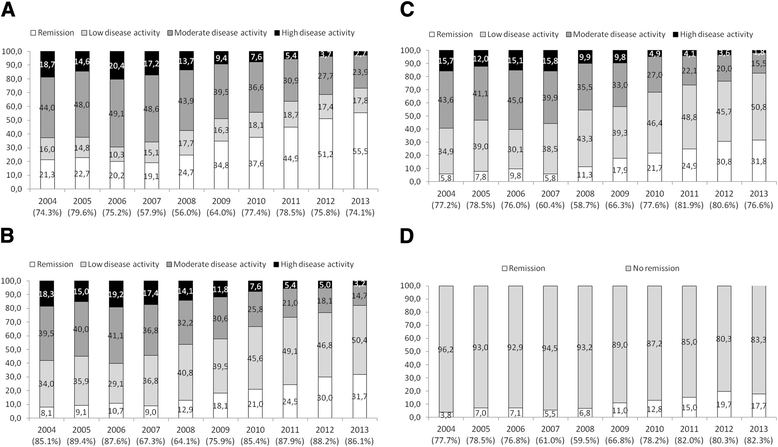Ten years of change in clinical disease status and treatment in rheumatoid arthritis: results based on standardized monitoring of patients in an ordinary outpatient clinic in southern Norway
- PMID: 26290061
- PMCID: PMC4545980
- DOI: 10.1186/s13075-015-0716-0
Ten years of change in clinical disease status and treatment in rheumatoid arthritis: results based on standardized monitoring of patients in an ordinary outpatient clinic in southern Norway
Abstract
Introduction: In the new millennium, clinical outcomes in patients with rheumatoid arthritis (RA) have improved. Despite a large number of register data, there is a lack of data reflecting the entire outpatient RA population, and in particular long-term data. The main aim of this study was to explore changes in clinical disease status and treatment in an RA outpatient clinic population monitored with recommended outcome measures over a 10-year period.
Methods: Standard data collected included demographic data, erythrocyte sedimentation rate, C-reactive protein, clinical measures of disease activity (Disease Activity Score in 28 joint counts [DAS28], Clinical Disease Activity Index [CDAI], Simplified Disease Activity Index [SDAI] and global assessments) and patient-reported outcomes (measures of physical function, joint pain, fatigue, patient global assessment and morning stiffness). Treatment with disease-modifying antirheumatic drugs (DMARDs) was also recorded, as well as rheumatoid factor (RF) and anti-citrullinated protein antibody (ACPA) status.
Results: In the RA population, the mean age was approximately 64 years and disease duration was 10-12 years. About 70 % were females; approximately 20 % were current smokers; and 65-70 % were positive for RF and ACPA. During follow-up, disease activity improved significantly. When we applied the DAS28, CDAI, SDAI and Boolean criteria for remission, the proportions of patients in remission increased from 21.3 %, 8.1 %, 5.8 % and 3.8 %, respectively, in 2004 to 55.5 %, 31.7 %, 31.8 % and 17.7 %, respectively, in 2013. The proportions of patients with DAS28, CDAI and SDAI low disease activity status were 16.0 %, 34.0 %, and 34.9 %, respectively, in 2004 and 17.8 %, 50.4 % and 50.8 %, respectively, in 2013. A significant improvement in patient-reported outcome was seen only for the full 10-years, but not for the last 4 years, of the study period. The proportion of patients taking synthetic (about 60 %) and biologic (approximately 30 %) DMARDs was stable over the last 4 years of the study period, with no significant change observed, whereas the proportion of patients being treated with prednisolone was reduced significantly from 61 % in 2010 to 54 % in 2013.
Conclusions: The encouraging data we present suggest that the vast majority of patients with RA monitored in outpatient clinics in the new millennium can expect to achieve a status of clinical remission or low disease activity.
Figures

References
-
- Pincus T, Sokka T, Kavanaugh A. Relative versus absolute goals of therapies for RA: ACR 20 or ACR 50 responses versus target values for “near remission” of DAS or single measures. Clin Exp Rheumatol. 2004;22(5 Suppl 35):S50–6. - PubMed
-
- Sokka T, Hannonen P, Mäkinen H. Remission: a realistic goal in rheumatoid arthritis? Int J Clin Rheumatol. 2011;6:643–7. doi: 10.2217/ijr.11.56. - DOI
MeSH terms
Substances
LinkOut - more resources
Full Text Sources
Other Literature Sources
Medical
Research Materials

